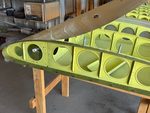3-23-25
Fuel tank venting plumbing
Because of the number of incidents where folks have reported losing the vented fuel caps in flight I opted to use non-venting fuel caps and install a vent system between the tanks. By the time I reached this point in my build, a solution for the vented caps had been found and reported on the Bearhawk forums but as I'd already purchased the necessary materials to use the non-vented caps I continued with this plan.
I had vacillated back and forth between limiting the venting of the tanks to just within in each wing or to vent all 4 tanks together but in the end, I opted to limit the vent system to each wing. To achieve this, I had to install a bung on the outboard side each main tank but was able to use and existing bung on the inboard side of the two Aux tanks.
I then ran a 3/8" aluminum fuel line along the top of the PVC conduit (which will house my electrical wiring) and installed the appropriate fittings to join the main tank and aux tank to the vent fitting (from JDAir.com) that was located on the lower surface of the wing tip. The vent line was secured to the PVC conduit with mylar tape and wire lacing. The whole assembly was then placed into the wing leading edge and secured to the spar and end ribs with 0.040" angles and a half-round clamp.
I used 3/8" fuel line for consistency with the rest of the fuel system but for the venting portion, a 1/4" line would have worked just fine as well.
In an effort to reduce or even eliminate fuel running from the vent system, I installed a Andair one-way check valve at each tank which will prevent fuel spillage but also has a pressure relief setting of 1.5 PSI in case the tank internal pressure becomes too high as can happen with full tanks on a hot day.

